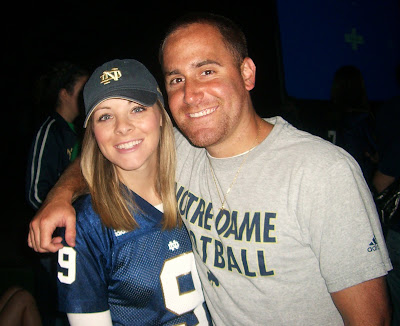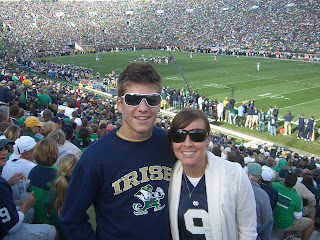Hey football fans (and fan-nots)! Happy FRIDAY!
One more week until college football season is upon us! It's time to start studying up! Today we're just starting with the basics! So put your reading glasses on, or contacts in, get ready to learn some good ol' football facts. Trust me, the football fan (or man) in your life might be impressed with what you're about to know!
The Objective
The object of the game is to outscore your opponent by advancing the football into their endzone for as many touchdowns as possible while holding them to as few as possible. There are other ways of scoring, but a touchdown is usually the prime objective
The Field
Learning the exact dimensions of the field is not necessarily that important, but it is good to have a basic knowledge of the field itself.
• The playing field is 100 yards long.
• It has stripes running across the field at five-yard intervals.
• There are shorter lines, called hash marks, marking each one-yard interval. (not shown)
• On each end of the playing field is an end zone (red section with diagonal lines above) which extends ten yards.
• The total field is 120 yards long and 160 feet wide.
• Located on the very back line of each end zone is a goal post.
• The spot where the end zone meets the playing field is called the goal line.
• The yardage from the goal line is marked at ten-yard intervals, up to the 50-yard line, which is in the center of the field. After reaching the 50-yard line, the yardage markers start to descend (40, 30, 20, 10) every ten yards until they reach the opposite goal line.
The Teams
• Each game features two teams playing against each other.
• Each team is allowed 11 men on the field at a time. Any more than 11 could result in a penalty.
• Unlimited substitution is permitted, but players may only enter the field when the ball is dead.
• Each team is comprised of an offense, defense, and special teams.
• If team A has possession of the ball, they use their offensive team to attempt to advance the ball toward the opponents endzone.
• If team B has the ball, team A will use their defensive team to attempt to stop team B from advancing the ball.
• If a kicking play is expected, both teams will use their special teams
Beginning of the Game
• Before each game, the captains from each team and the referee meet at the center of the field for the coin toss.
• The winner of the coin toss has the option of starting the game by kicking the ball to the other team or receiving the kickoff from the other team.
• The game begins when one of the teams kicks off to the other.
• The receiving team must catch the ball and try to advance it as far back toward the kicking team as possible.
• The play ends when the player with the ball is knocked to the ground (tackled), or makes it all the way to the kicking team's endzone (touchdown).
• The spot where the kick returner was tackled becomes the line of scrimmage. The line of scrimmage is a term for the place the ball is spotted before a play is run.
• Once this starting point is established, the offensive squad of the receiving team will come in and try to move the ball toward the opposition's end zone.
What is Down and Distance?
Understanding down and distance is probably the biggest key to understanding football, so make sure you really understand this part before moving on to the next section.
• Basically, a down is a play. From the time the ball is snapped (put into play), to the time the play is whistled over by the officials, is considered one down.
• A team's offense is given four downs (plays) to move ten yards toward the opponent's end zone.
• Distance is the number of yards a team needs to get a new set of four downs.
• If they make the ten yards needed within four downs, they are given a new set of downs. This is called getting a first down.
• If they don't make it the required ten yards, the other team's offense takes possession of the ball.
Fourth-Down Strategies
If a team fails to gain the required yardage on third down, several things could happen on fourth down:
• A team can elect to "go for it" on fourth down and try to pick up the remaining yardage, but they run the risk of turning the ball over to the other team if they do not get to the first down marker. If they do not get the required yardage, the other team takes possession of the ball at the spot of the last tackel and now has four downs to move ten yards back in the other direction.
• The majority of the time, teams will elect to "punt" the ball away on fourth down. A punt is simply a form of kicking the ball that gives possession of the ball to the other team, but also pushes them back considerably farther away from the end zone.
• Another option is to kick a field goal. If a team feels they are close enough to kick the ball between the upright bars of the goal post in their opponent's endzone, they may attempt a field goal, which is worth three points when converted successfully.
After a Score
• After a team scores via a touchdown or field goal they must, in turn, kick off to the other team, and the process begins all over again.
(Yes I possess this knowledge, but the above can be referenced at www.football.about.com)









































